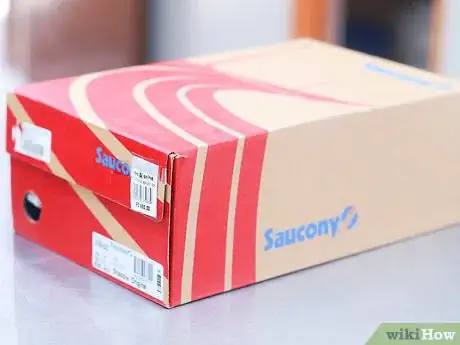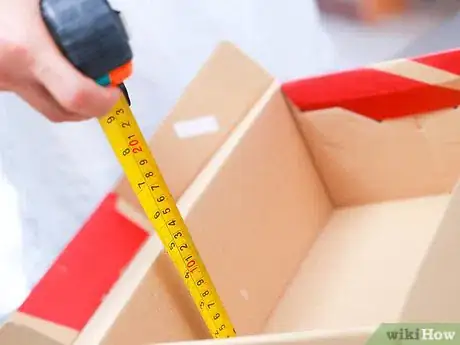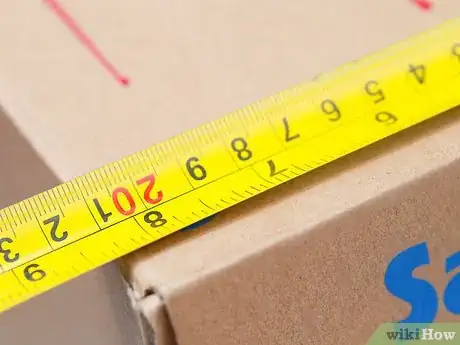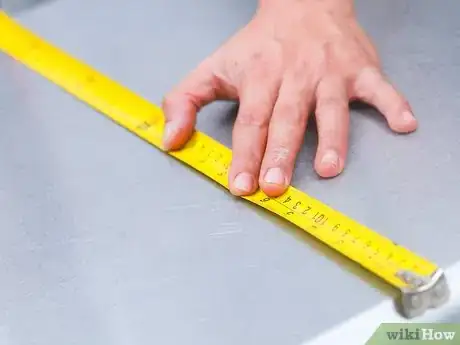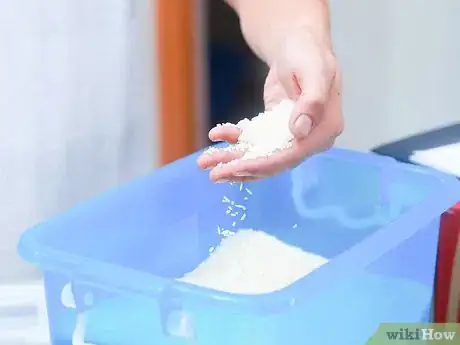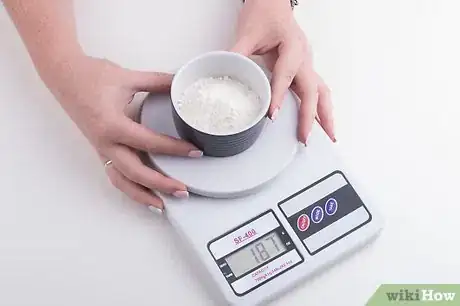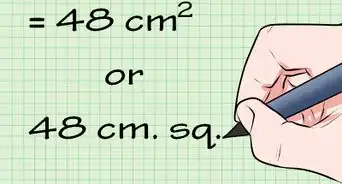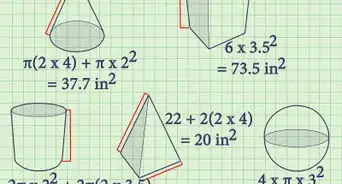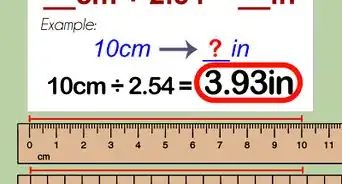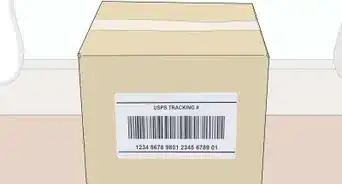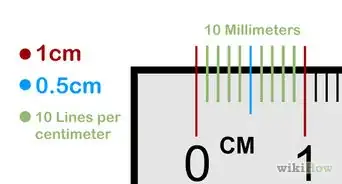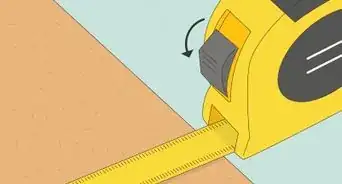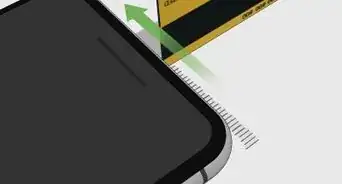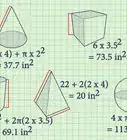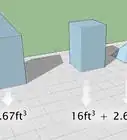This article was co-authored by Mark Spelman. Mark Spelman is a General Contractor based in Austin, Texas. With over 30 years of construction experience, Mark specializes in constructing interiors, project management, and project estimation. He has been a construction professional since 1987.
This article has been viewed 55,468 times.
You need to know whether something will fit into a box, or whether the box will fit into another space. You can use a tape-measure, a ruler, or any other distance reference that displays inches and centimeters. You will need to determine the length of each side, the height and depth of the box, and the size of any related forms: the things that must fit inside the box, and the space in which the box will rest.
Steps
Measuring a Rectangular Box
-
1Place the box on a flat surface. If the box opens at one end, arrange the open side up. This way, it'll be easier to measure the inside.
- You will need a tape-measure, a ruler, or any other standardized distance reference. You will be measuring your box in either inches or centimeters, depending on your location and your purposes. Be sure to use a reference that displays the relevant units.
- Keep writing materials at your disposal: a pen, a pencil, or word processor. You could also use a phone or other handheld device. Write down each measurement as you take it, lest you forget.
-
2Measure the inside of the box. You will need to know the length, the width, and the depth. If you are trying to figure out whether something will fit inside the box, then you need to measure the inside. Box sizes for mailing and shipping always correspond to the inner dimensions of the container.
- Measure the length: Hold a tape-measure or a measuring stick along the longest inner side of the box. Press the tip of the measure into one corner of the box, and stretch the tape along the length of the long side to the adjacent corner. Record the number where the non-zero end of the tape-measure meets the adjacent corner of the box. If the box is rectangular, you can assume that the other "long" side is the same length.
- Measure the width: Hold a tape-measure or a measuring stick along the shorter inner side of the box. Press the tip of the measure into one corner of the box, then stretch the tape across the short side to the adjacent corner. If the box is rectangular, you can assume that the other "short" side is the same length. If the width matches the length, then the box is square.
- Measure the depth: Press the tape-measure into the bottom of the box, along any side, and stretch the tape up to the open top of the box. Keep the tape perfectly parallel with the creases in the corners of the box, and record the number that sits where the tape measure meets the top edge of the box.
Advertisement -
3Measure the outside of the box. If the walls of your box are particularly thick, the exterior measurements may differ somewhat from the interior measurements. If the walls are very thin, you can probably just use the interior measurements. In any case, you will need to know the length, the width, and the height.[1]
- Measure the length: Hold a tape-measure or a measuring stick along the longest outer side of the box. Hold the 0-end of the measure against one corner of the box, then stretch the tape along the length of the long side to the adjacent corner. Record the length.
- Measure the width: Hold a tape-measure or a measuring stick along the shorter outer side of the box. As with the length, hold the tip of the measure against one corner of the box, then stretch the tape along the short side to the adjacent corner. Record the width.
- Measure the height: Hold the tip of the tape-measure against the bottom of the box, along any side, and stretch the tape up to the open top of the box.
-
4Take careful measurements. In most casual cases, you can round to the nearest inch or centimeter.[2] If the box must hold an object of a very specific size, and you are not absolutely sure that the object will fit – record the nearest half-inch, quarter-inch, or eighth-inch. Most tape-measures are accurate to the nearest millimeter (1/10 cm) or 1/16 inch. This is all that the casual box-measurer will need.
Measuring Space
-
1Measure the space where the box will sit. If you are planning to fit the box into a specific space—say, you are building a planter box for your garden, or you are stacking boxes of belongings into a moving van&messy;make sure to check your box measurements against that space.
- Measuring a space is much like measuring a box. If your box needs to fit along three axes—length, width, and height—then measure those axes. If your box only needs to fit into a two-dimensional space on the ground, and height is not an issue, then only measure the length and the width.
- If you can physically bring the box to the space where it will rest: do so. This is the easiest way to ascertain whether the box will fit. If you cannot do so, visit the space with a tape-measure and the box dimensions that you wrote down. Imagine that the box is sitting in the space before you, and use the tape-measure to mark out the edges of the box.
-
2Calculate the area of each side. Simply multiply the length of a side by its width to find the area. In most cases, you will not need to know the area of the box sides – but it may come in handy to know how many boxes you can fit into, say, a five-foot-by-five-foot storage space.
- For example: If the bottom of the box is 10 inches wide and 15 inches long, you can multiply 10" x 15" to get 150 square inches. This is the area of the bottom of the box.
Calculating the Volume of a Box
-
1Consider whether you need to know the volume of your box. If you are filling the box with a material that flows—like earth, sand, a liquid, or a gas—rather than large, discrete objects, then it may behoove you to calculate the volume.
- Volume is measured in cubic inches, cubic centimeters, cubic feet, etc. A "cubic inch" describes a cube with three measurements—length, width, and height—that each measure exactly one inch. In order to find the volume, thus, you will need to multiply the length of the box by the width of the box by the depth of the box.[3]
- If the box has thick walls (thicker than, say, a quarter inch), be sure to multiply by the interior depth rather than the exterior height.
-
2Know the volume of whatever you'll put into the box. If you are filling a box with something, it is not enough merely to know the volume of the box. You will also need to figure out how much (of the earth, sand, liquid, etc.) you have, and compare that figure to the size of the box itself.
- You might use a program for this rather than doing the calculations yourself. Try searching online to find a suitable one.
-
3Multiply length by width by depth (L x W x D).[4] If your box is square or rectangular, this will give you the volume in cubic inches. For example: if your box is 10 inches wide, 15 inches long, and 9 inches deep, you'll multiply 10" x 15" x 9" to get 1350 cubic inches. You can use an online unit converter to find the volume in liters, gallons, or other units.
- If your box holds an irregular shape, consider using an online volume calculator for more complicated equations: http://www.calculator.net/volume-calculator.html
Expert Q&A
-
QuestionWhat does length x width x height mean?
 Mark SpelmanMark Spelman is a General Contractor based in Austin, Texas. With over 30 years of construction experience, Mark specializes in constructing interiors, project management, and project estimation. He has been a construction professional since 1987.
Mark SpelmanMark Spelman is a General Contractor based in Austin, Texas. With over 30 years of construction experience, Mark specializes in constructing interiors, project management, and project estimation. He has been a construction professional since 1987.
Construction Professional This is the formula that will tell you the volume of the box.
This is the formula that will tell you the volume of the box.
References
- ↑ http://www.watermanswebworld.com/code/measure.html
- ↑ https://www.ups.com/content/us/en/resources/prepare/oversize.html
- ↑ https://www.khanacademy.org/math/pre-algebra/measurement/volume-introduction-rectangular/v/volume-of-a-rectangular-prism-or-box-examples
- ↑ http://www.aaamath.com/geo79_x7.htm
- ↑ http://www.uline.com/CustomerService/Uline_FaQ_Ans.aspx?FAQ_ID=57
About This Article
To measure a box, start by measuring the longest inner side of the box to get its length. Then, measure the shorter inner side to check the width. Next, measure from the bottom of the box to the top of its side to obtain its depth. Alternatively, measure the outside of the box if you want to find out if it can fit into a space. For tips on how to calculate the volume of a box, keep reading!
